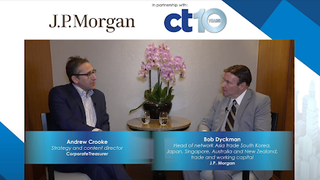
J.P. Morgan’s View: How virtual accounts really work

By streamlining a treasury’s processes, virtual accounts enable businesses to make smarter decisions. J.P. Morgan’s Martijn Stoker, head of APAC liquidity and escrow services, and Manoj Dugar, head of APAC core cash management product, outline how virtual accounts boost treasury efficiencies.
Q. What makes virtual account attractive?
There has been a lot of discussion over the past 12 months about how virtual accounts can advance corporate treasury by mitigating the challenges that come with managing physical accounts.

Corporates who operate a large number of bank accounts – in some cases, in the thousands – often experience difficulties in tracking and reconciling their payments and collections. There is also a significant cost in opening, maintaining and closing these accounts, with firms having limited control over this process, which can take months.
Virtual accounts, which are provided to a company by its banking partner, are linked to that company’s physical bank account. They enable a company to segregate cash within its physical account, eliminating the administrative workload, complexity and costs associated with holding additional physical accounts for different functions or lines of business.
Anecdotally, J.P. Morgan has heard corporates asking how virtual accounts differ from virtual reference numbers (VRNs). While VRNs – which have been around for several years – are a great way to monitor receivables, they do not aid with payments, real-time liquidity or account rationalisation.
In contrast, virtual accounts essentially operate like physical accounts; they have their own account numbers and support both payments and receipts. Virtual accounts and VRNs can work together to provide a fully integrated virtual accounting and straight-through reconciliation service.
Q. What is the difference between virtual and physical accounts?
In a nutshell, virtual accounts have all the capabilities of real bank accounts, but with added flexibility and self-service functionality.
Like physical accounts, virtual accounts have unique account numbers providing clients access to all pay, receiving and reporting functions. Account numbers can be assigned by the bank or chosen by the company. Virtual accounts can also participate in a notional pool or cash concentration structure, cover a single or multiple entity structure, and track, report, and settle inter-company loan positions.
In practice, a virtual account hierarchy is underpinned by a single physical account header, with as many virtual accounts as needed sitting underneath. Payments and receipts can be processed through each virtual account while the actual fund movements take place through the physical header account.
Q. Why should treasurers go virtual?
Segregating accounts across different businesses and functions is challenging. Multiple physical accounts are often needed to keep cash flows distinct and trackable, but this adds to administrative workloads and costs.

Virtual accounts enable companies to:
- reduce the number of bank accounts
- simplifying the cash management structure
- provide the same level of control and individual reporting
Rationalisation also comes with added benefits of real time cash concentration and the ability to set up single and multi-entity virtual accounts helping companies to centralise their processes at the same time.
One challenge many companies’ face is that reported bank data differs from how they want to view and understand that data. Obtaining analysis in the form the corporation needs, may have to be done manually and is both costly and inefficient.
Virtual accounts provide the flexibility to structure, segregate and aggregate data. Companies can slice and dice reporting according to their business needs. Intercompany reporting is also available for companies with multi-entity hierarchies.
The use of disparate technologies including various enterprise resource planning systems makes account reconciliation challenging. Getting bank account data into those systems is time consuming, and is often a manual process. The ability to customise reporting makes it easy to automate reconciliation without expensive middleware to translate bank data.
While the opening, closing and altering of physical accounts is time consuming and paper-intensive, virtual accounts can be set up and maintained through a self-service portal.
The portal makes it easy for companies to alter account structures, settings and entitlements. It also provides the ability to create an unlimited number of virtual bank accounts, in some cases within minutes.
Corporates are able to also move from physical to virtual accounts, and back, while still being able to retain their account number, an important feature for acquisitive clients or those undertaking a divesture.
Q. Will I be able to consolidate all my bank accounts to a single, physical account?
We at J.P. Morgan often hear treasurers ask whether an ideal state of having one physical bank account with all other accounts virtual, will become a reality. While this is unlikely to happen due to regulations, it is expected that treasurers will be able to operate from a smaller number of physical bank accounts bringing treasury efficiencies of improved transaction visibility, real-time liquidity and account rationalisation.
Q. Is it easy to set up?
Clients can deploy J.P. Morgan’s Virtual Account Management (VAM) platform seamlessly without major disruptions in their cash management processes. VAM was designed in-house to ensure that it connected to the bank’s product ecosystem. The platform is easy to use and will quickly drive better visibility, efficiency and reporting clarity.
To learn more, please contact:
Martijn Stoker
Head of APAC Liquidity and Escrow Services
Treasury Services, J.P. Morgan
Manoj Dugar
Head of APAC Core Cash Management Product,
Treasury Services, J.P. Morgan



